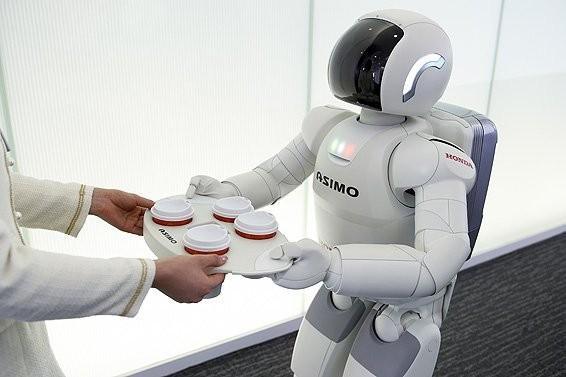Why do your own laundry when your robot can do it for you?

How Honda developed the world’s most advanced humanoid robot, and sold it to no one.
Imagine a world where instead of having to pick up after yourself or argue with your significant other about whose turn it is to do the dishes, your friendly household robot would clear the table and clean your plates for you. In this world, your grandmother would not struggle to carry heavy groceries from her car, and you would no longer have to worry about her slipping on the ice while retrieving the newspaper at the end of her driveway.
Engineers from Honda Worldwide had exactly this dream over 30 years ago, and spent two decades developing ASIMO, a walking, talking, dancing humanoid robot capable of anything from serving your guests cocktails at a dinner party, to assisting with mundane household chores like vacuuming or making your bed.
So why don’t you have one of these nifty gadgets to cook your meals and dig you out of that giant pile of laundry that haunts you on Sunday mornings when you’re trying to read your cases? Because ASIMO, despite being introduced to the public in 2000, is not for sale. In fact, Honda has not released any formal communication indicating how or when the company intends to take the robot to market (cue: eyebrow raise).


…say what?
It’s natural to speculate that perhaps, in an age where concerns continue to brew about the future of job security for low-skilled workers, a robotics company might be weary of releasing a product that could be perceived as a threat to those on the lower end of the income spectrum. Terrifying Hollywood movies featuring robots controlling humans probably don’t help that much either. However, while Honda continues to dwell in silence, Softbank’s Pepper and NAO seem to be stealing the spotlight, along with a cast of other humanoid robots available for purchase online. Although the success of many of these robots is hotly contested, and Softbank’s Robotics division rumored to be running in the red, there is something to be said for being courageous enough to take the plunge into the commercial market and for accepting the challenge of gradually winning over technology skeptics. [3]
If a company is going to invest unspeakable amounts of time and money into developing a humanoid robot – one it says could drastically improve the lives of elderly and disabled individuals – why not just take the product to market and see what happens? Or at least share concerns about doing so with the world, so maybe someone can help come up with a solution to whatever is stopping them?

Although the potential of the ASIMO robot and technological advances made by the engineers who have devoted their careers to the project are undeniably impressive, I give Honda’s management team a grade of F for failing to create any value for customers in the 30+ years since the birth of the project. As of today, I would argue that the only value created is educational, although useful information shared outside Honda’s walls remains limited given the firm’s commitment to secrecy. Value captured is also zero (unless ASIMO is raking in a bunch of cash handouts behind the scenes for his occasional guest appearances on talk television). As for the future his disaster relief cousin E2-DR, let’s just say I won’t be holding my breath.
Sources:
[1] http://world.honda.com/ASIMO/history/
[2] https://www.newscientist.com/article/dn8456-humanoid-robot-gets-job-as-receptionist/
[3] https://asia.nikkei.com/Business/Companies/SoftBank-s-humanoid-robot-is-274m-in-debt
[4] https://www.ald.softbankrobotics.com/en/robots/pepper
[5] https://spectrum.ieee.org/automaton/robotics/humanoids/iros-2017-honda-unveils-prototype-e2dr-disaster-response-robot



Interesting post, CNH! I would also agree that the value captured is zero, unless Honda has been secretly partnering with another organization or has licensed or sold the technology at some point over the last eighteen years!
I have never heard of ASIMO and I am surprised that I have not read more about the project, especially as companies are increasingly investing in robotics. It is fun to think of a world with ASIMO; it would be a useful product for a variety of customer segments. My only concern would be the price point. I think that it would take some time to develop the technology and master the manufacturing of it to make it widely available around the world.
I’m also wondering why Honda chooses to keep this a secret? I would think that Honda would publicize the project in order to build hype and keep internal resources devoted to its development.